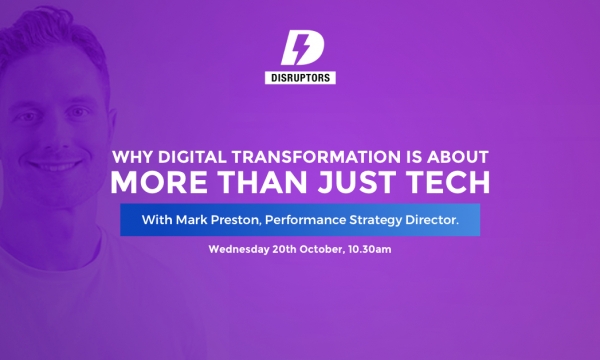Just what will be the big trends, the big stories and the key things that could influence your strategy in 2020? We asked the Stickyeyes team for their views on what they think we’ll be talking about in the coming year.
In-housing should change the agency operating model

Glen Conybeare, Managing Director
It’s hard to ignore the growing trend of in-housing. Whilst it’s fair to say that some agencies have well and truly stuck their heads in the sand, there are some indications that show us both which way the wind is blowing, and what the true commercial value of in-housing is.
Large organisations are increasingly talking about how in-housing is one of their priorities (or at least, an area of interest) in the coming year and beyond. We’re hearing this from clients and we’re seeing more prospects and RFPs talking about in-housing as a future aim and ambition. Whilst many of these mentions are at the early stages, it’s fair to say that these organisations are looking at those that are already in-housing with a very close eye on whether and how it works.
The larger companies that are doing it are already clearly setting a trend. Whilst we haven’t seen an explosion in the number of brands looking to bring agency resource within their own four walls, it’s clear that boardrooms are looking for ways in which they can drive efficiency through this route.
It’s also important to look at what is (and isn’t) being brought in-house. Our experience is showing that companies are happy to in-house the more commoditised end of the marketing mix, whilst still relying on agency specialisms for the more strategic elements. Will they do more than this over time? Almost certainly, but perhaps quite sensibly they are learning to walk before they can run.
For agencies, it is inevitable that this will force them to change their thinking and adapt. What we have seen so far is a lot of commentary and a lot of platitudes, but no real change in approach. Certainly when it comes to the larger networks, there has been a reluctance to grab that particular hornet's nest, but that is a short-sighted approach.
As agencies, we must remain relevant to the needs of the clients we serve. When their wants and needs change, the onus is on us to adapt to, rather than resist, those changes. If that means allowing our clients to license our proprietary tech, seconding our people to client sites or running in-housing training, it’s up to you to respond to those challenges positively.
That is what we are now doing at Stickyeyes. We now license our proprietary technology, something we never thought we’d do. We have a growing number of our people based either full or part-time on client premises. We have some clients who just use us for audience insights, preferring to then make their own execution decisions based on that insight.
The simple truth is that in-housing is here and it is going to get bigger in 2020. It's something that we're being asked about, and a service that we're more frequently providing. The question is whether agencies are willing and able to adapt to reflect this reality.
The ‘R’ word will be top of the agenda

Matthew Barnes, SEO Manager
From EAT to the BERT update, one trend that remains constant is the way that Google is adapting its algorithm to put a greater emphasis on contextual relevancy.
The emphasis is not necessarily on the keywords, but what those keywords actually mean in different contexts and the thematic meanings involved in a search journey. Google is better understanding which words within a conversational query are important, and which are unimportant, to the context of the query.
Both the BERT and EAT updates were followed by a lot of discussion around “how you can optimise for” the respective update. This is the wrong question. The question is not about optimising for a particular update – that will only result in you trying to hit a constantly moving target – but instead about optimising for the contextual relevancy for the consumers immediate need.
The priority for brands is to therefore ensure that they are active within the conversations that they are relevant for. The issue is not just about getting referrals, or even “high quality” referrals, but referrals within the right circles, the right discussions and for the right reasons.
The year of the customer

Phil Kissane, Group Managing Director
I am predicting (and hoping) that 2020 becomes the year of the customer. Rather than talk about marketing as a number of different siloed channels and tactics with different briefs and engagements, we will start asking the fundamental question around what marketing actually is – who is our audience, how do we connect with them, build a relationship and, ultimately sell them the right thing?
The audience should be at the centre of this universe and everything should revolve around them. We hear that attention spans are getting shorter and shorter and that may be the case, but the ability of brands to make a connection with their audience has never been higher. Is it a failure of brands and agencies that has created this attention deficit? Is it a failure to recognise that bombarding is not building a relationship and is, instead, just noise?
Although we are on the cusp of a brave new world in terms of what data and insight can bring, let’s not forget it’s the same as it ever was. It’s all about the people, people.
Looming privacy regulations mean that we can’t just throw data at the problem

Laura Smales, Account Director
Consumer privacy is continuing to evolve globally, with increased focus on user privacy and transparency around the usage of data. This is going to make it even harder for advertisers to target users based on behaviour in the digital world.
We aren’t just talking about hypotheticals or “what if” scenarios here either. This is happening right now. The privacy functionality on the iPhone has already been updated to auto-clear browser cookies to just one day - including cookies from third party ad networks such as Google and Facebook. Google is updating the Chrome browser to provide data transparency for consumers around how they are being tracked using cookies across the web. New privacy tools are also being rolled out across Google Maps, YouTube and Assistant.
It means advertisers are going to have less data to play with, and that there are going to be more regulations and restrictions on the data that they do have.

Phil McGuin, Director of Demand Generation
The big regulatory change for 2020 is the California Consumer Privacy Act (CCPA) - the so called “GDPR for the US”.
It’s the first state-wide act in the US aimed at protecting the data privacy of its citizens but although it operates at state level, its provisions cover out-of-state merchants that sell into California.
Combine the CCPA with GDPR and you have two powerful pieces of legislation that cover two of the most important economic areas in the world. Businesses cannot afford to simply shy away from these regulations particularly if, as we expect, more states within the US adopt their own version of the California act.

Michael Hewitt, Content Marketing Manager
Regulators around the world have realised the flaws in letting the foxes guard the hen house. For all that Silicon Valley has talked a good game when it comes to “taking the privacy of our users seriously”, consumers remain either blissfully unaware or surprisingly outraged at how their data is being used.
Privacy legislation and regulations are tightening and it is inevitable that they will eventually, if not completely catch up, close the gap considerably.
From GDPR and the tightening of cookie rules, through to the CCPA and the looming spectre of the European Privacy Directive and cookie-less browsing, this regulatory environment fundamentally changes the game in terms of how marketers and advertisers strategise, deploy and behave.
For a long time, so many challenges were answered by throwing more data at the problem. If the ads weren’t hitting the right audience, advertisers turned to even more data to make sure that the targeting was even more focussed. If brands wanted to join up online and offline, beacons were plastered across shopping malls to pinpoint and bombard audiences that, however fleetingly, might have possibly glanced at the shop window display.
The data will still be there, but how we can and can’t use it will change dramatically over the course of the coming years. That puts the onus back onto coming up with propositions, stories and creative that connects with the customer on a emotional level, not just on a level that the data suggests is right. Rubbish that is highly targeted was, is and always will, be rubbish.
More automation will come to Google Ads

Sarah Barker, Head of Biddable Media
We saw a lot of changes to the Google Ads interface in 2019 and I'm anticipating that there will be more to get used to in 2020.
This year we saw the removal of average position, the introduction of smart shopping and we saw a super-charged recommendations tab complete with score and easy on-click recommendation implementation. That’s before you mention the introduction of new exact match close variants that made way for broader matching than ever before.
I think that we can expect more of these types of changes, particularly those that urge us to give more trust and control to the algorithm. Although there's a lot of scaremongering around these types of advancements, I personally see many of the changes as a positive and we shouldn't be afraid to adapt. We need to find ways to make the most of these.
These changes represent another step towards more automated marketing and smarter metric analysis that will allow us to shift our focus to the bigger picture. I wouldn't be surprised if more keyword-less campaign options become available. I’d even suggest that we’ll see changes to what Google factors into quality score to add further value to some of these updates.
Informational content will be replaced by a greater focus on intent-focussed copy

Jonathan Brown, Senior Content Editor
I was going to title this “the death of the blog” but thought that was a bit dramatic. Though with the introduction of the EAT update last year and the way that Google is developing the algorithm, the idea that certain companies – especially those in the YMYL sector - can produce four blogs a week on something that they have the authority to talk about is becoming more and more fanciful.
I think we’ll see brands adapting their strategies to focus on improving their functional content so that all product and category pages are laser focussed on user intent. They’ll then produce informational content that will be closely related to their products – which may well actually sit on the product pages instead of tucked away in a blog. This would be guides, how-to pieces, explainers etc. On top of that I’d expect maybe one or two longer thought leadership, news focussed or purely audience engaging pieces a month that explain the big topics in that sector to their audience.
I think Google’s move away from keyword-focussed pieces to topics, and its push for more natural language, will back this up. Instead of having a list of keyword areas to focus on, we’ll instead be given topics that are important to both the company and the audience to cover.
Writers will write unnaturally naturally

Peter Adams, Content Editor
For writers, 2020 will be a year of creative freedom mixed with doubt – same old, same old, then.
This time, it’s because of BERT - the Google update that aims to make more sense of natural language. It’s the latest shift towards rewarding quality and follows the 2018 E-A-T update, which – among other things – gave big green ticks for long-established editorial standards (primary sources, balance, bylines etc).
Now BERT has come along telling us write naturally, to fit the purpose of the page, and to write for our audience, not Google. Writing a blog? That’s fine, don’t worry about cramming in keywords. Product page? No shame in that, just be clear about it. But then here comes the doubt – BERT still has a little way to go yet. If you run a long piece of copy through the tool, it’ll give high saliency to seemingly random words.
In 2020, we’ll have more freedom – but we’ll have to find Google’s limit.
SEO agencies need to focus on problem solving, not ‘off-the-peg’ strategies

Jack Nottidge, Senior SEO Lead
SEO strategy should be based on problem solving and the strategy put in place should be based on solving issues that they have.
Those problems often run deeper than simply ranking or traffic challenges. They can be revenue challenges, technical problems or issues with customer engagement. But what we often come across are strategies that purely focus on those ranking and traffic challenges, perhaps just hoping that the rest will fall into place.
There was never a time for “off the shelf” SEO strategy, but I sincerely hope we see an end to that approach for good in 2020.

Richard Hird, SEO Lead
We still come across many brands and SEO agencies relying on blanket checklists and templates. Many of these, whilst not inherently wrong, don’t account for the nuances of how every brand operates. SEO agencies should not be spending time obsessing about technical fixes that they know the client cannot get through the dev queue, yet we still see that happening. The emphasis needs to be on overcoming that issue in a holistic and collaborative manner.
And in 2020, I genuinely believe that we will start to see brands and agencies collaborate across search marketing channels to ensure that SEO and PPC compliment each other. This is something we’re doing a lot here at Stickyeyes and it means that brands get the best of both worlds – a responsive strategy that ensures that budgets are deployed based on where it is effective to do so, not just because that is the agreed budget split.
We’ll ask (and answer) more questions

Vincent Krasauskas, Senior Content Executive
Over the summer we learned that 49% of all US Google searches ended right there on the results page. It begs the question – is the rise of the featured snippet culminating in a zero-click game?
As content creators strive for the snippet to demonstrate their authority and knowledge in their particular field, users can grab key pieces of information and have their questions answered without feeling the need to click any further.
If your brand wants to be the answer, it needs to be the one asking the question – through carefully crafted, expertly applied informational content spanning all kinds of how-tos, whys and hows. Twinned with the call-and-response served up by voice search, it’s more important than ever to, quite literally, have all the answers.
Authenticity will be more important than ever

Rebecca Chambers, Digital Designer
In a world of fake news, body-tune apps and plastic surgery filters on social media, we have been seeing much more of a swing the opposite way, with consumers expecting (and in many cases, demanding) more authenticity from brands and publishers.
When choosing imagery, brands should be looking to depict real people in real situations. Shutterstock have added an 'authentic' filter to their search results; a response to the growing popularity of less staged and polished imagery. We've also seen a rise of smaller, boutique stock image sites, as demand grows for more unique and original imagery to help brands put their message across. Freckles, scars and stretch-marks are no longer being airbrushed out and consumers are coming to expect to see a more interesting and diverse range of people represented in advertising.
With this comes a demand for authentic content from brands that shows a transparent and authentic behind-the-scenes look into the business. Whether that's an infographic explaining production processes, involving your consumers in the development of a new product via social media, video dispatches from the factory floor or a campaign featuring testimonials from real employees, consumers are increasingly looking for that authentic story. This messaging should reach a consumer across all touch points in order for it to resonate.
More than ever, brand marketing is about trying to create an emotional connection with customers. The best way to do this is by keeping things authentic, transparent and real.
Google’s “badge of shame” will lead to more speed-focussed development

Ryan Hale, Junior Developer
Towards the back end of 2019 we saw that Google has been making a concerted push on making sure it only ranks high performing, quick-loading sites near the top of pages for key search terms. What we also know is that next year, Google may start to warn users if a site is slow to load or slow to use. Clearly, whilst page speed is not a new topic of discussion for Google, it expects brands to move much more quickly on this issue.
Of course, no brand wants to see this ‘badge of shame’ associated with their brand so you can expect to see a large focus on page speed-orientated development in 2020.
For many brands, the issue can be addressed with some relatively easy fixes but you can also expect to see development focusing on factors, such as reducing and streamlining website features, latest-generation image formatting and reducing “first paint” times to as low as possible. This will help to make sure that our page sizes are as small as possible and our load times are as fast as possible.
Although it may be a shock at first, I feel this will be a step in the right direction in pushing towards a quicker and more user-friendly browsing experience for all.
SEO will (or should) get involved at the start of the decision-making process – not the end of it

Jack Clark, SEO Lead
We’ve handled our fair share of website migrations this year and the most consistent lesson from all of them is that the sooner SEO gets involved, the better it is for everyone.
This might sound like a no-brainer but it’s disturbingly easy to make a decision, ‘bake it in’ to a new website framework and only then find out from an SEO specialist that the decision will massively affect rankings, traffic and visibility in the search results.
This could be something like removing key traffic driving pages with no replacements lined up, building a JavaScript-heavy framework that will make Google’s job harder to do, or even something as simple as just ‘redirecting everything to the homepage’.
It’s about time SEOs got involved at the start of the process, not just when we push hard enough to ‘get a seat at the table’, so to speak. Failure to do this will only result in what we’ve seen all too much – a brand approaching us after things have gone wrong.
Please let this be the year that brands finally act like human beings!

Lisa Wisniowski, Brand Communications Director
It continues to astound me that in 2019 many brands still forget that their customers are real-people. There has been a wealth of news reports and cringe-worthy case studies this year which have hit the headlines where marketing teams have ignored their research (or not even bothered to do it in the first place) and therefore have no idea how to reach the people that matter to them.
Admittedly the increase in ‘big data’ and the move to automation have created their challenges but, when customer information and improved processes are harnessed effectively, brands should be able to be more targeted and personable than ever before.
The good news is that we, as marketers, are also human beings – talk to your customer as you like to be spoken to, avoid corporate speak (unless appropriate), use natural language, show emotion and make your customers feel like you understand and appreciate their wants and needs. In turn, you’ll hopefully be rewarded by increased brand awareness and improved brand emotion which can drive customer loyalty and repeat brand purchase. It’s not as difficult as you might think!
The age of Excel reporting is ending, to be replaced by simpler reporting

Jonny Briggs, Data & Analytics Manager
After years of building detailed Excel reports, dropping in masses of data and watching the file size exceed email attachment limits, it's looking like 2020 may be the end of Excel reporting.
With reporting increasingly becoming a burden for both clients and agencies as digital strategies evolve and the data requirements that power them being more and more varied, Excel struggles to stay relevant to the task.
Enter Google Data Studio.
Providing flexibility and numerous integrations, Data Studio is making reporting a much more lightweight process. It means that the time taken to manually populate a report can be spent on optimisations and gaining true insight from reports. And as Google continues to improve this platform into 2020. we will see a dramatic shift to dynamic and more genuinely insightful reporting.

Tom Johnson, Account Manager
It’s no secret that brands are becoming increasingly conscious of not only what they are reporting on, but how accurate and usable it is. We have all seen those huge marketing dashboards that are packed full of metric after metric, but how much of it is used, understood and acted upon?
As brands try to close the loop between their various marketing platforms, we may see a trend of simplifying these reporting regimes to ensure that brands can make sense of what their spend is returning across those channels and platforms.
AI text generators will become commercially available

Steve Clarkson, Content Editor
Artificial intelligence is already capable of creating content. We actually discussed the very topic earlier this year when we looked at the possibilities of GTP-2 (a text generator by OpenAI) that can produce human-quality articles and even novels using its own initiative.
AI text generators will become commercially available in 2020 - enabling brands to produce unique content at speed and scale. When this happens, today’s writers will become tomorrow’s editors. They’ll take responsibility for briefing (or programming) text generators to tone of voice, preferred sources and SEO best practices - then check and upload the content produced.
The emergence of AI text generators isn’t something content creators need to fear - it will free us up to become better marketers, storytellers and strategists.
Bigger doesn't mean better

Jasmine Kendal, CRM Manager
We’ve entered an age where less is more, and this applies to email too. With users shifting more and more towards mobile and wearable technology, usability and readability with ‘to the point’ and simple email design are essential. After all, the space we have to work with as email marketers is decreasing and as a result, users don’t have the time (or space) to figure out what your email is trying to say to them. If it doesn’t grab their attention in the first two seconds of opening, then I can guarantee it’s heading straight for the junk folder.
‘Bigger doesn’t mean better’ doesn’t only apply to the amount of copy in your email, it also applies to the amount of people you send your emails to. Gone are the days of having a database of 100k+ contacts. I’d much rather be talking to a small highly engaged pool of people than to a huge database with an open rate of below 10%. Consumers now expect to be spoken to as a human, and this includes through email as well. They want to be approached with content and products they’ve shown to you they like, not just a generic email sent to an entire database.
Yo consumers are far from stupid, so a short simple email design containing information that’s relevant to the end user is the way forward in 2020. Our users are evolving with the digital times, adopting new technologies and ways of digesting content, as email marketers we need to evolve with them or fear being left in the dust.
The rise of useful AR

Adam Pickard, Senior Digital Designer
Augmented Reality is already popular in its more gimmicky formats through the likes of Instagram and Snapchat, but I can see that we will see more brands experimenting and making good commercial use of AR technology in the coming year.
There are examples of useful AR already but in many cases, you have to download a specific app for a specific purpose to make use of the technology. In many cases, the big barrier between AR and consumers was accessibility.
Google has recently updated its engine to allow users to search for specific things and view them in their house or office using AR. For example, try googling “hedgehog”, “wolf” or “tiger” on your phone.
With this in mind it's only a matter of time before we will be able to view products, clothing and furniture in AR without downloading a specific app. In 2020 we will start to see the rise of this trend, early adopters will start integrating their websites with Google’s new system, the barrier to entry will have been lowered and the rise of useful AR will be underway.
Voice search will boom in 2020

Danny Porter, Senior Account Executive
Forgive me if you’ve heard this one before, but I think we will see much more growth in voice search in 2020.
We see the usual stats every year about how many Alexa and Google Assistant devices will be under the Christmas tree, but they are growing in popularity and search engines are adapting to reflect more conversational and natural forms of search.
It isn’t the devices themselves that are driving this change. The devices are simply facilitating existing consumer behaviour and the direction of travel already being taken by the search engines – much like smart phones did previously.
It present lots of opportunity for brands adopt a simplified route to purchase, something which most brands will be keen to take advantage of and I’m sure that the brands that do embrace this technology quickly will reap the rewards. I’m looking forward to seeing how they can leverage this new technology to reach audiences in new creative ways.
More joined-up thinking with digital video

James Pierechod, Multimedia Designer
Online video ad spend is forecast to overtake that of traditional broadcast for the first time ever in 2019. The IAB’s Video Advertising Spend Report also predicts 25% growth in online video spend in 2020. So far, so good, if you’re in the online video business.
But as online video starts to command a greater share of the budget and makes up a larger proportion of the marketing mix, it’s inevitable that strategies will have to adapt to reflect the increased scrutiny and demands than come with that.
That will result in more joined up thinking between traditional ad agencies, brands, and digital agencies to help unify campaign distribution across all platforms (digital, OOH, and traditional media). We are going to see more instances of creative thought being applied (in pre-production) to social cuts, shorter platform specific narrative journeys, and alternative social funnels. Providing a far richer, more inclusive creative campaigns.
The growth of the curation economy

Kevin Lawson, PR & Social Campaign Manager
One area I’ll be keeping an eye on is the growth of the “curation economy” (yes, that is a term I’ve made up). As consumers, we’ve become addicted to comparison services – we want to know how to get as much as we can for as little as we can, and we want to know that in as few clicks as possible.
A good example could be the SVOD streaming platforms – a market that looks set to become extremely saturated as every publisher with even the slightest back catalogue seems to be setting up their own SVOD platform. We know that Britbox and Disney+ will be the next new kids on the block but, when consumers already have their Netflix, Amazon Prime, Now TV and possibly their cable or satellite package on top, just how many subscriptions are consumers prepared to take on? That strikes me as a market that is ideal for a ‘Compare the Market’ style service.
I think we’re going to see more services and toolsets that make curation and comparing of products and services much easier. How that impacts the brands and search results that are impacted by those tools and services remains to be seen, but if the financial services and travel sectors provide a good case study, it’s going to bring plenty of challenges.


